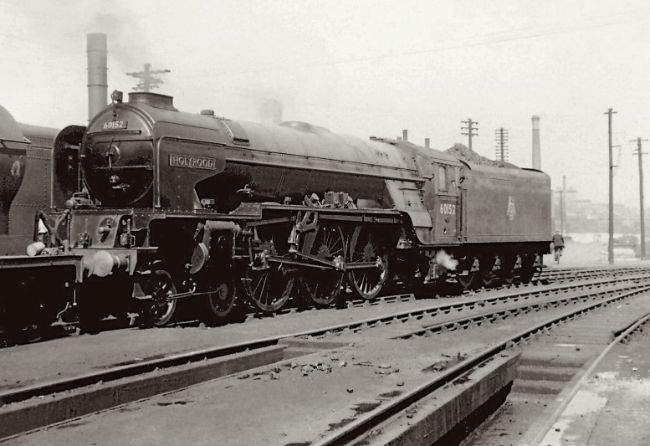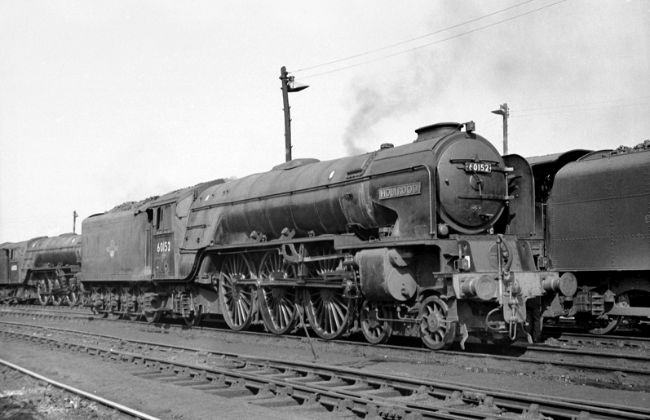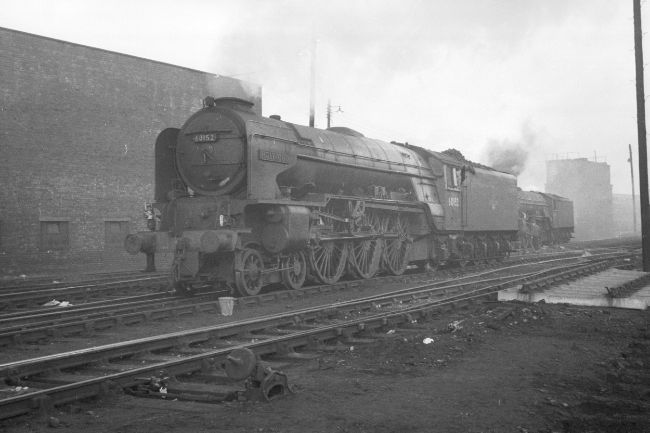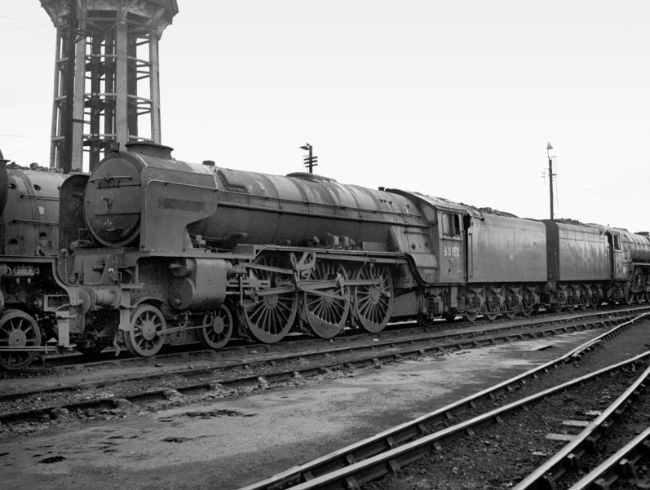No. 60152, Works No. 2071, emerged from Darlington Works on 8th July 1949 fitted with a Diagram 118 boiler (No. 3975), carrying apple green paint with black and white lining and equipped with the Darlington trademark, a smooth-sided tender assembled with flush-headed rivets. Like all A1s to wear this livery the legend ‘BRITISH RAILWAYS’ was painted in Gill Sans on the tender. The locomotive’s initial allocation was to Haymarket shed (HAY), the start of a long relationship with Edinburgh and Scotland that was to last for almost its entire life. Its initial duties were largely confined to the northern reaches of the East Coast Main Line (ECML), receiving a ‘Light Casual’ at Doncaster during June 1950 before being transferred to Polmadie shed (66A) in Glasgow on 14th January 1951. The move to the former Caledonian Railway shed for duties on the West Coast Main Line (WCML) was in marked contrast to the work of the rest of the class, No. 60152 being set to work on the up West Coast Postal and returning on the 12:50hrs Birmingham-Glasgow. The locomotive was noted on another ex-Caledonian Railway shed, Eastfield (65A), on 4th February.

No. 60152 at Haymarket wearing express passenger blue livery but still with a plain chimney – Eric Vogel
On 11th March 1951 No. 60152 was transferred back to Edinburgh Haymarket (now 64B) before being sent to ‘The Plant’ for general repairs on 30th April, an overhaul that saw it emerge on 1st June having been repainted in BR express passenger blue with black and white lining and adorned with the name Holyrood. The Palace and Chapel of Holyrood in Edinburgh fulfilled the role of Royal Residence in Scotland for Scottish and British monarchs through the centuries and the name is another Walter Scott connection to Peppercorn’s Class A1 Pacifics. Apart from featuring in his novels, Holyrood was the centre of attention when Scott became the master of ceremonies during King George IV’s visit Scotland in August 1822, the first Hanoverian monarch to do so. The author played a leading role in organizing the visit which was a carefully stage-managed event marking the rehabilitation of Scotland by the British monarchy, a process continued by Queen Victoria who, in large part inspired by the works of Scott, set about restoring the building so that the Palace of Holyroodhouse became once again, a royal residence. It was therefore entirely appropriate that No. 60152 Holyrood should spend almost all its career allocated to Edinburgh sheds.
In a further break with A1 routine, No. 60152 paid a visit to the ex-Caledonian Railway works at Cowlairs for non-classified repairs on 23rd June 1951 before returning to Doncaster on 27th October 1952 for a general overhaul and its first boiler change, leaving ‘The Plant’ on 21st November carrying boiler No. 29841 and BR express passenger green, lined in orange and black with the early BR emblem on the tender. Holyrood was promptly sent back to Polmadie shed again, arriving there just after Christmas, to resume its work on the WCML, being recorded on the 11:50hrs Crewe-Glasgow service on St. Valentine’s Day and its regular turn on the West Coast Postal on 14th April 1953. After minor attention at Cowlairs and Polmadie in April and May respectively, No. 60152 was moved back to Haymarket on 29th June for a stay that would last ten years. After a ‘Heavy Intermediate’ at Doncaster between 9th June and 20th July, 1954 found Holyrood in charge of a number of named trains including the up ‘Queen of Scots’ on 11th December and the up ‘Heart of Midlothian’ on 28th and 29th of the same month. No. 60152 was a regular performer on these trains throughout 1955 although it became a failure whilst working the 10:50hrs Carlisle- Niddrie goods on 6th July, being taken off the train at Hawick. 1955 concluded with a visit to Doncaster (7th November – 17th December) for a ‘General’ including the fitting of boiler No. 29827.

Holyrood at Darlington in final condition, complete with electric flashes – Bill Reed
1956 found No 60152 once again routinely deployed on the up ‘Heart of Midlothian’, the locomotive being recorded working this service on 3rd March, 15th and 26th May but it was also noted on the 14:00hrs Carlisle-Newcastle train on 2nd September. Following a call at Doncaster between 6th May and 15th June 1957 (receiving boiler No. 29865) Holyrood started to appear on a greater variety of trains which included working a Newcastle-King’s Cross parcels train to The ‘Cross on 10th July, an Edinburgh-Aberdeen service on 8th September and the up ‘Aberdonian’ from Aberdeen on 9th February 1958. After seeing out the year at Doncaster undergoing a general overhaul which included the fitment of boiler No. 29851, Holyrood re-entered traffic on 16th January 1959 and began a year that included multiple visits to Carlisle, the locomotive being recorded on Canal shed (12C), an ex-LMS shed, on 2nd August and 2nd September and working the 14:20hrs Niddrie-Carlisle goods on 2nd April 1960. After a spell at Doncaster Works for a general overhaul during November when it acquired boiler No. 29827, Holyrood started to make frequent visits to Gateshead shed (52A) for servicing, often having worked the down ‘Queen of Scots’, a pattern that persisted until an unclassified repair at Doncaster in May 1962 after which it began to appear regularly at Heaton shed (52B) for servicing.

Holyrood circa 1964 – John Arnott-Brown
On 21st March 1963 Holyrood paid its final call at Doncaster, receiving its last boiler, No. 29831, during a general overhaul, leaving the works on 23rd May. Less common turns worked that year included handling a Derby-Morpeth Pigeon Special from York on 29th June and a Millerhill-Kingmoor freight on 5th September, just days before its transfer to another Edinburgh shed, St. Margarets (64A), on 9th of that month. However, the glory days were over and the locomotive was allocated increasingly menial duties such as the 3S46 York-Edinburgh parcels train on 8th October, the 2G85 Newcastle-Berwick on 14th May 1964 and other freight and light passenger turns until its final re-allocation to York (North) shed (50A) on 6th September. Eking out its last days at York, Holyrood was more often on standby than actually in use although it was noted on the 1N84 Bristol-Newcastle train on 29th January 1965. No. 60152 was officially withdrawn from York (North) shed on 21st June and was last seen at Oxley shed on 10th October, probably en route to J. Cashmore of Great Bridge for scrapping.

Shorn of name and numberplates, No. 60152 awaits its fate at York in 1965 – Bill Reed
This history was compiled by Graham Langer based on a database compiled by Tommy Knox and with reference to the RCTS book ‘Locomotives of the LNER Part 2A’ as background.